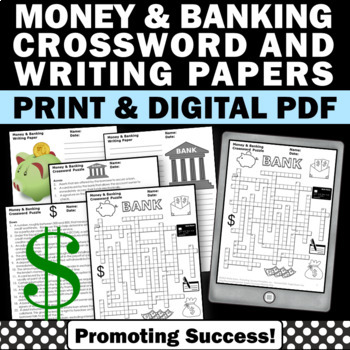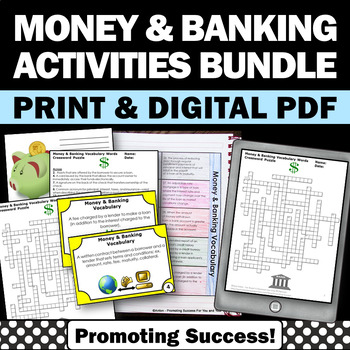Note: This blog post contains products from our Teachers Pay Teachers store and Amazon Affiliate store.
---------------------------
Financial literacy is the ability to understand how money works in the world: how someone manages to earn or make it, how that person manages it, how he/she invests it (turn it into more) and how that person donates it to help others.
Please watch this video, then scroll down for teaching ideas, activities, games and lessons for teaching 5th grade, 6th grade, middle school, high school and special education students financial literacy concepts.
Please watch this video, then scroll down for teaching ideas, activities, games and lessons for teaching 5th grade, 6th grade, middle school, high school and special education students financial literacy concepts.
Financial Literacy: Mellody Hobson at TEDxMidwest
1. Suppose you had $100 in a savings account and the interest rate was 2 percent per year. After 5 years, how much do you think you would have in the account if you left the money to grow?
More than $102; Exactly $102; Less than $102; Do not know; Refuse to answer.
2. Imagine that the interest rate on your savings account was 1 percent per year and inflation was 2 percent per year. After 1 year, how much would you be able to buy with the money in this account?
More than today; Exactly the same; Less than today; Do not know; Refuse to answer.
3. Please tell me whether this statement is true or false. “Buying a single company’s stock usually provides a safer return than a stock mutual fund.”
True; False; Do not know; Refuse to answer.
In the United States, 38 percent of men answered all three questions correctly compared with only 22 percent of women.
In the Netherlands, 55 percent of men and 35 percent of women got all three right, and in Germany the results were 60 percent for men and 48 percent for women.
In a 2016 Survey of the States, there were several key findings regarding financial literacy:
Since 2014, two additional states include personal finance in their K-12 standards and require those standards to be taught.
While more states are implementing standards in personal finance, the number of states that require high school students to take a course in personal finance remains unchanged since 2014 – just 17 states.
Only 20 states require high school students to take a course in economics – that’s less than half the country and two fewer states than in 2014.
There has been no change in the number of states that require standardized testing of economic concepts – the number remains at 16.
Financial literacy should begin in middle school and high school, not in college or even after college!
Here is a free teaching resource to help you assess your students' basic understanding of financial literacy concepts.
Click HERE for free financial literacy task cards for kids.
-------------------------------
Here are 7 financial skills recommended for high school:
Here are more printable teaching resources on TpT:
Click HERE to download this financial literacy crossword puzzle.
This bundle will save you money! (no pun intended!)
Click HERE for more resources from Edutopia.
---------------------------------------
You may also like these resources from our Amazon affiliate store:
(from the video above)
Too much debt? Not enough savings? Stop your whining and get to work. It's time to become a battle-ready financial warrior, prepared to tackle any money challenge. Modeled on the Soldier's Handbook, which is issued to all new U.S. Army recruits, Soldier of Finance is a no-nonsense, military-style training manual to overcoming financial obstacles and building lasting wealth.
---------------------------------------------
Bestselling 5 Star Graduation Gift for both College and High School grads!
Why do high schools and colleges require students to take courses in English, math and science, yet have absolutely no requirements for students to learn about personal money management? Why Didn't They Teach Me This in School?
99 Personal Money Management Lessons to Live By was initially developed by the author to pass on to his five children as they entered adulthood. As it developed, the author realized that personal money management skills were rarely taught in high schools, colleges and even in MBA programs. Unfortunately, books on the subject tend to be complicated, lengthy reads. The book includes eight important lessons focusing on 99 principles that will quickly and memorably enhance any individual's money management acumen. Unlike many of the personal money management books out there, this book is a quick, easily digested read that focuses more on the qualitative side than the quantitative side of personal money management. The principles are not from a text book. Rather, they are practical principles learned by the author as he navigated through his financial life. Many are unorthodox in order to be memorable and provoke deeper thought by the reader. Not only an excellent graduation gift for high school and college students but also a great read for any adult!
ALSO AVAILABLE IN SPANISH - "POR QUE NO ME ENSENARON ESTO EN LA ESCUELA?"
---------------------------------------
Financial Literacy for Millennials: A Practical Guide to Managing Your Financial Life for Teens, College Students, and Young Adults
A modern primer on consumer finance and personal money management intended for readers aged 15 to 30, this guide can also serve as a primary text for high school, college, or adult education courses on personal finance.
• Provides an understanding of the structure and institutions constituting the U.S. economic system
• Shares knowledge about consumer finance and financial planning to enable young people to make better choices in their lives
• Shows how to save and invest prudently and use debt wisely and effectively
• Prepares millennials for the financial impact of life events so they will be empowered to take control of their financial futures
• Includes a series of tips that summarize the important lessons from the book
---------------------------------------
A modern primer on consumer finance and personal money management intended for readers aged 15 to 30, this guide can also serve as a primary text for high school, college, or adult education courses on personal finance.
• Provides an understanding of the structure and institutions constituting the U.S. economic system
• Shares knowledge about consumer finance and financial planning to enable young people to make better choices in their lives
• Shows how to save and invest prudently and use debt wisely and effectively
• Prepares millennials for the financial impact of life events so they will be empowered to take control of their financial futures
• Includes a series of tips that summarize the important lessons from the book
---------------------------------------
Learn how to plan and manage your personal finances, achieve a financially successful life, and take responsibility as a citizen. PERSONAL FINANCIAL LITERACY, Second Edition, is aligned with the Jump$tart Coalition's National Standards for Personal Financial Literacy. The personal focus of this course makes it relevant and meaningful to all; in particular, to those just starting down the path to personal financial independence.
---------------------------------------
Click HERE to view our Teachers Pay Teachers Promoting Success store.

Shelly Anton is a participant in the Amazon Services LLC Associates Program, an affiliate advertising program designed to provide a means for sites to earn advertising fees by advertising and linking to Amazon.com. ** This means there are Amazon affiliate links in these blog posts. This does not mean you pay a dime more when you purchase a product through the link. It just means I am trying to save you valuable teacher time by making it easier for you to find valuable resources for your students, and I earn a few cents for my research and time. Thank you for all you do for kids!









This comment has been removed by a blog administrator.
ReplyDelete